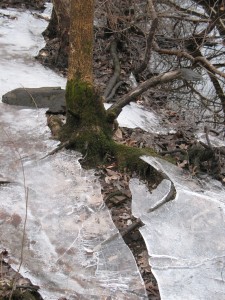Note: the core of this entry comes from an essay “You Have to Be Here – Teaching Thoreau in Concord,” published in the Winter/Spring issue of Appalachia, which features a number of pieces about Thoreau and his influence. Link: http://www.outdoors.org/publications/appalachia/
Martin Luther King Day always makes me think about freedoms, the ones we take for granted and the ones we see as threatened. Famously, King had a dream about freedom, and, almost as famously, he had a method for approaching freedom. That he traced some of this method of civil disobedience to Henry Thoreau is equally well known. When my students and I read Walden and its meditation on freedom and enslavement, and then read Frederick Douglass’ autobiography and On Civil Disobedience, I ask us all this question: We go out with our freedom for what? Thoreau wrestles with this question throughout his work, saying at one point, “Don’t just be good; be good for something.”
While this question arrives early in the semester, as the term ages, we return to it, especially when we reach the end of Thoreau’s Walden “experiment,” (he is insistent on using this word in its scientific fullness; Walden itself can be read as a sort of poetic lab report) and consider his landmark essay, “On Civil Disobedience.”
Early in Walden, Thoreau launches a startling comparison: “It is hard to have a southern overseer; it is worse to have a northern one; but worst of all when you are the slave-driver of yourself.” I read this aloud and look out over the class. They have all taken a required and demanding United States history class; they are versed in the long nightmare of slavery and its ongoing effect on relations in our country. They have read Thoreau’s contemporary, Frederick Douglass, and his story of self-liberation, first from illiteracy and then from his southern overseer. “What do you think of that?” I ask.
“Pretty easy to say for a free white man who gets to go home for dinner whenever he wants,” says Percy, giving summary voice to generations of readers nettled by Thoreau’s finger-pointing and crowing and what seems to them posing. But here we are at the heart of Thoreau’s moral universe, and in “Civil Disobedience” he works to answer Percy’s charge. What should he, a free, white man, do in his era, when he saw slavery as its primary metaphor and evil? His answer is complex, and we wrestle with its various reasonings as we read his essay that has rippled beneath and through protest and change movements around the world. “So different,” says Charlotte of the writing. “Where’s the nature, the pond looking back at him, the friendly pine needles, the neighborhood animals and misfits?”
“It’s true,” I think and say. “The language of ‘Civil Disobedience’ is moral and mechanical. “Let’s look at his advice about response to society’s machinery when its turns unjustly.” We turn to a midpoint in the essay and Tessa reads aloud: “If the injustice is part of the necessary friction of the machine of government, let it go, let it go: perchance it will wear smooth—certainly the machine will wear out. If the injustice has a spring, or a pulley, or a rope, or a crank, exclusively for itself, then perhaps you may consider whether the remedy will not be worse than the evil; but if it is of such a nature that it requires you to be the agent of injustice to another, then, I say, break the law. Let your life be a counterfriction to stop the machine.”
“What would that look like?” I ask in the quiet that follows.
“Heat and pain,” says Adam, and physics students chime in with friction’s characteristics, describing the burn of being rubbed the wrong way, or, at length, any way at all. While Thoreau was facile with machinery—see his family’s pencil business and Thoreau’s improvements to it—he did not love its promise as central to whatever improvements or revolutions might better people and this world. For that hope he turned to the individual. And part of Thoreau’s appeal to high school students is their kindred feeling that they, with their questions and insights, should be and are counterfriction to the machine of the societies they will inherit.
“Our whole life is startlingly moral,” Thoreau writes in the Higher Laws chapter of Walden, and once you are awake to this perception, prodded perhaps by the insistent finger of his prose, life gets complicated. I look out over my classroom, full of both privilege and promise. Bent to their books, bowed some by the work of becoming, they are, even in their wearied states, inspiring.
Like Thoreau, I have put much of my faith in a better world in the “I” each one represents, and in what each may do with her or his freedoms.


